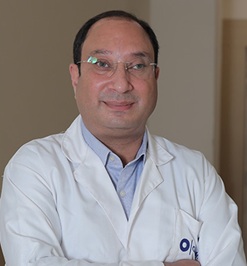Revision Total Knee Replacement Surgery

Treatment Duration
2 Hours
------ To ------3 Hours
Treatment Cost
₹ 3,50,000
------ To ------₹ 5,00,000

Table of Contents
- What is Revision Total Knee Replacement Surgery?
- Conditions treated with Revision Total Knee Replacement Surgery
- Who needs Revision Total Knee Replacement Surgery?
- How is Revision Total Knee Replacement Surgery performed?
- What to expect before and on the day of the Revision Total Knee Replacement Surgery?
- What to expect after Revision Total Knee Replacement Surgery?
- Benefits of Revision Total Knee Replacement Surgery
- Risks and Complications of Revision Total Knee Replacement Surgery
- Risks of Delaying Revision Total Knee Replacement Surgery
- Cost of Revision Total Knee Replacement Surgery
Revision Total Knee Replacement Surgery is frequently necessary when a knee replacement stops working correctly. A surgeon replaces the old device with a new one during this surgery.
Revision Total Knee Replacement Surgery is considered highly successful due to the improved implant designs and modern-day surgical techniques. In some cases, the implant inserted in the knee during the knee replacement surgery loosens or wears out over time. It needs to be revised through another surgery. The revision knee replacement recovery processes are similar to the primary knee replacement operation. However, the recovery period for revision total knee replacement surgery may be longer.
Surgery name |
Revision Total Knee Replacement Surgery |
| Alternative name | Knee Revision Replacement Surgery |
| Diseases treated | Infection, Dislocation of the implant, Instability or stiffness of the knee, Trauma or fracture |
| Benefits of the surgery | Relief from chronic knee pain, Swelling, Increased mobility, High success rate |
| Treated by | Orthopaedic surgeon |
You can check Revision Total Knee Replacement Cost here.
What is Revision Total Knee Replacement Surgery?
Revision Total Knee Replacement surgery comes in a variety of forms. Sometimes only one implant or prosthesis component needs to be changed. In other cases, the femoral, tibial, and patellar components must all be removed or replaced, and the bone surrounding the knee must be repaired using bone grafts.
Anatomy and Physiology of the Knee Joint
The knee joint consists of tendons, ligaments, muscles and bones, all working together to provide knee stability during movement.The knee joint is a combination of three bones:
- Thighbone(femur)
- Shinbone (tibia)
- Kneecap (patella)
In revision surgery, one or all of the three components - femoral, patellar and tibial - require removal, and the bone surrounding the knee must be reconstructed with augments.
After assessing the damage to the bone, the doctor will need to make a call regarding the usage of specialised implants with thick, larger stems that fuse deeper with the bone and give extra support.
Revision Total Knee Replacement Videos by HexaHealth
Expert Doctors (10)
NABH Accredited Hospitals (10)


Conditions treated with Revision Total Knee Replacement Surgery
- Infection
- Trauma or Fracture
- Dislocation of the implant
- Instability or stiffness of the knee
Who needs Revision Total Knee Replacement Surgery?
- People who have had a knee replacement at a young age and whose implants have deteriorated due to loosening or wear and tear
- If the artificial joints have become infected causing stiffness and pain in the knee joint
- When the ligaments have been damaged, causing the implant to stop functioning properly, thus resulting in knee instability
- Fractures around the knee joint
How is Revision Total Knee Replacement Surgery performed?
- Reshaping a bone
- Eliminating bony fragments
- Readjusting the original implant
- Replacing the implant with a new one
- At first, the surgeon follows the line of incision made during primary knee replacement surgery. However, the incision may be longer than the previous one to allow the removal of the old implant.
- After an incision, the surgeon exposes the knee joint by moving the tendons and kneecap aside.
- He/she then examines the soft tissues to rule out any possibility of infection.
- The surgeon also checks the metal and plastic parts of the implant to identify the worn-out or loosened parts.
- If required, the whole implant and cement (used in the primary knee replacement) are removed while saving as much bone as possible.
- Once the implant is removed, the surgeon prepares bone surfaces for revision implant.
- In case of significant bone loss around the knee, metal augments and platform blocks are added to the main implant components to compensate for the bony deficits.
- In rare cases, bone graft materials are required to rebuild the knee. The surgeon may take the graft from the patient’s bone (autograft) or a donor (allograft).
- Finally, the surgeon inserts the revision implant, repairs the surrounding soft tissues if damaged and checks the motion of the knee joint.
- A drain is placed to extract fluids and blood from the knee joint that may remain after the surgery.
What to expect before and on the day of the Revision Total Knee Replacement Surgery?
Before the Surgery
- The patient needs to reveal information regarding all the medicines he/she has been taking, including non-prescription medicines such as Aspirin.
- Blood thinners, including certain anti-inflammatory medicines and vitamin supplements, should be avoided before the surgery as per the doctor’s advice, as they can increase bleeding.
- The doctor takes imaging tests like an X-ray to examine the area around the knee implant. It also helps in determining if the implant has loosened up or dislocated. An X-ray can also identify the presence of bony fragments.
- An MRI or CT scan is sometimes required to identify any tissue damage which is not visible in the X-rays.
- The doctor takes the patient’s blood test to rule out the possibility of an infection.
- In some cases, knee aspiration is also required to diagnose a joint disorder. Aspiration is the procedure to extract fluid from in and around the knee joint.
On the Day of Surgery
An anesthesiologist evaluates the patient to determine if he/she would require general or regional anaesthesia. General anaesthesia is induced to put the patient to sleep during the surgery, whereas regional anaesthesia only numbs the body from the waist down while the patient remains awake.What to expect after Revision Total Knee Replacement Surgery?
Recovery process at the hospital
- The health care providers shift the patient to a recovery room to monitor the vitals and the after-effect of anaesthesia.
- Once the effect of anaesthesia wears off, the patient is transferred to a hospital room where he or she must stay for several days.
- Pain and discomfort are not uncommon after the surgery. Healthcare providers give pain-relieving medicines for faster recovery.
- The doctor or a physical therapist suggests specific exercises to strengthen the leg and restore the range of motion.
- Foot and ankle movement is encouraged immediately after the surgery to prevent blood clotting.
- The doctor can also recommend reducing blood clotting in the leg with compression stockings, inflatable leg coverings (compression boots), and blood thinners.
- The doctor may also prescribe antibiotics before and after the surgery to prevent infection.
Recovery process/ expectation after hospital discharge
- The site of the incision is to be kept clean and dry.
- The patient must follow specific bathing instructions to avoid water touching the incision site.
- He/she must do regular exercises as instructed by the doctor to improve the strength and mobility of the knee joint. One of the common exercises is straightening the leg and then bending the knee to at least 90 degrees of flexion.
- If the doctor has advised the use of crutches or cane, the patient must ensure their use until he/she feels comfortable walking without assistance.
First Follow Up Appointment
Usually, the patient visits the doctor two weeks after the surgery or as per the instructions. During the appointment, the doctor examines the incision to ensure the wound is healing properly. He/she gives follow-up instructions regarding the removal of sutures or stitches. The sutures beneath the skin need not be removed as they dissolve on their own.Benefits of Revision Total Knee Replacement Surgery
- Relief from chronic knee pain and swelling
- Increased mobility resulting in an active lifestyle
- High success rate and satisfaction
Risks and Complications of Revision Total Knee Replacement Surgery
- Blood clots in the legs or lungs
- Infection in the new implant
- Improper healing of the wound
- Loosing of the new implant (its risks are higher if the patient is overweight)
- Dislocation of the new implant
- Bone fracture during the surgery while removing the implant
- Joint infections may lead to the formation of a bone at the lower end of the femur. This process is known as heterotopic ossification.
- Damage to the blood vessels or nerves
When to Consult a Doctor
- Bleeding from the incision site
- Swelling or redness around the incision site
- Fever or chills
- Increased pain even after taking pain-relieving medicines
Risks of Delaying Revision Total Knee Replacement Surgery
- Instability in the knee joint
- Reduced function in the knee
- Aseptic loosening (failure of the joint implant) leading to the degeneration of the bone tissue
Cost of Revision Total Knee Replacement Surgery
- Type of revision total knee replacement surgery
- Age of the patient
- The medical condition of the patient
- The type of hospital facility availed - individual room or shared.
| Procedure Name | Cost value |
| Revision Total Knee Replacement Surgery | ₹3,00,000 to ₹5,00,000 |
Last Updated on: 10 October 2023
Author
HexaHealth Care Team
HexaHealth Care Team brings you medical content covering many important conditions, procedures falling under different medical specialities. The content published is thoroughly reviewed by our panel of qualified doctors for its accuracy and relevance.



























